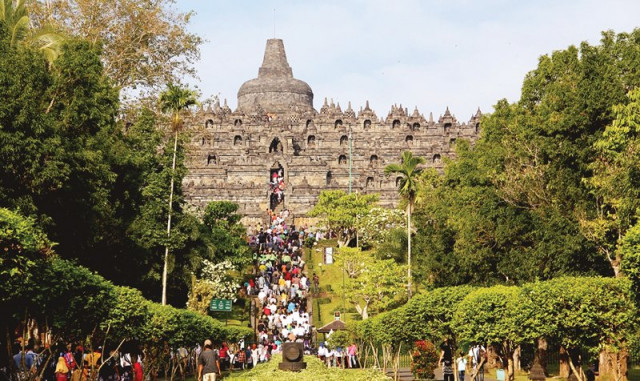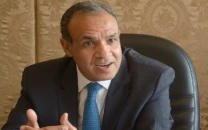Borobudur Temple: Restoring heights
A pilgrimage to Borobudur temple — Indonesia’s best kept secret.

Tourists and pilgrims are ascending to the top platform of Borobudur temple by its main entrance which is on the eastern side. PHOTOS: FAZAL KHALIQ

Bell-shaped stupas at Borobudur overlooking a mountain in Magelang. PHOTOS: FAZAL KHALIQ
The Borobudur temple, located at the centre of the Java Island, was built during the eighth and ninth centuries, during the reign of Syailendra’s dynasty. The main temple comprises a stupa, built in three tiers, that reflects the Indian influence in the region at the time. Along with the towering edifice, the majestic stone carvings on the temple walls depicting Buddha’s life transport you to another era.

Stairs of Borobudur through arches of Kala. PHOTOS: FAZAL KHALIQ
For a historical site to become part of the world heritage list, UNESCO has a unique criterion. The temple satisfies the following three of the ten: to represent a masterpiece of human genius, to exhibit an important interchange of development in architecture and be an outstanding example of significant stage(s) in human history. The lotus-type formation and the ten mounting terraces crowned by a large bell-shaped dome exemplify Buddhist architecture. The Borobudur temple grounds are a symbol of Indonesia’s art and architecture during the early eighth and late ninth centuries, and lastly, the 10 mounting terraces of the entire structure illustrate the 10 successive stages that the Bodhisattva (enlightened beings) must achieve before proceeding to Buddhahood — the state of perfect enlightenment in Buddhism.
Even though the temple is considered a prime tourism spot now, it was not always this glorious. In fact, it was buried under layers of earth and covered by thick jungle growth for decades. The temple was finally restored by UNESCO with the help of many volunteers between 1973 and 1982. Experts believe that a large volcanic eruption may have caused the burial of the temple and simultaneously driven away the local population. In 1814, Thomas Stamford Raffles, the British governor of the Java Island was informed about the lost monument in the jungle. HC Cornelius, a Dutch engineer, was sent off to investigate further. Two months and several rounds of razing trees and wild vegetation later, parts of the temple were revealed. It wasn’t until 1885, that the temple was unearthed completely. Since then the Borobudur temple has gone through several restoration programmes to reclaim its historical value.

A carved relief stone at the Borobudur temple. PHOTOS: FAZAL KHALIQ
Since its restoration, the number of visitors per day range from 3,000 to 7,000, including both locals and foreigners. However, during peak season the number increases to 40,000 visitors per day. The temple also hosts the holy festival of Vesak, during the full moon sighting in the month of May, and attracts pilgrims and tourists from across the world. The entrance fee per tourist is $20 (approximately Rs3,000) and there is a special discount of $10 (approximately Rs1,050) for students. The income generated through this fee is used for the temple’s maintenance and to empower local communities.
For pilgrims, the journey is a long one. They start at the base of the monument, following a path circumambulating the monument to ascend to the top, through the three levels of Buddhist cosmology: Kamadhatu (the world of desire), Rupadhatu (the world of forms) and Arupadhatu (the world of formless). The temple comprises 2,672 relief panels, and if arranged in parallel lines, the length will add up to six kilometres. However, the magical view during the climb is enough to keep one going. “When I saw this ancient monument, very strong feelings of wonder and excitement ran through me as it [the temple] is really beautiful and mysterious and I have never seen such a gigantic Buddhist temple before,” said a German tourist, Bendikt.
In order to preserve the sanctity of the temple, visitors also have to adhere to a strict dress code, consisting of a sarong provided by the temple management. Other restrictions include shoes, mini-skirts and shorts. Apart from tourists and Buddhists pilgrims, the Borobudur Buddhist complex is frequently visited by students who not only walk in the footsteps of the past but also feel a sense of pride in their history. A local student, Widiasti Suari, added, “We found the archaeological site of Borobudur temple very interesting and [the trip] added to our knowledge.”

Buddha’s statue at Borobudur temple. PHOTOS: FAZAL KHALIQ
While Indonesia may be synonymous with breathtaking beaches and hospitality, most tourists fail to discover its best kept secret. The Borobudur temple gives you a chance to not only witness Buddha’s legacy but also climb the monument that symbolises different levels of wisdom one must attain to reach Nirvana — an experience that could perhaps end up changing your life forever.

View of Borobudur temple from the south-east side. PHOTOS: FAZAL KHALIQ
>>Digging deeper
• An architect named Gunadharma supervised the build-up of the Borobudur temple which took 75 years to complete without using any computer assistance.
• Borobudur temple has 100 water gutters in the form of Makara (elephant-headed fish statue) which act as drainage channels and also enhance the beauty of the structure. In the past, when rainwater ran through the Makara, it gave an illusion of a fountain.
• Borobudur temple is a giant puzzle composed of two million volcanic stone cubes which are carved in such a way that they fit perfectly into each other.
Fazal Khaliq is a Swat-based reporter for
The Express Tribune. He tweets @FazalJustice
Published in The Express Tribune, Sunday Magazine, March 9th, 2014.



















COMMENTS
Comments are moderated and generally will be posted if they are on-topic and not abusive.
For more information, please see our Comments FAQ